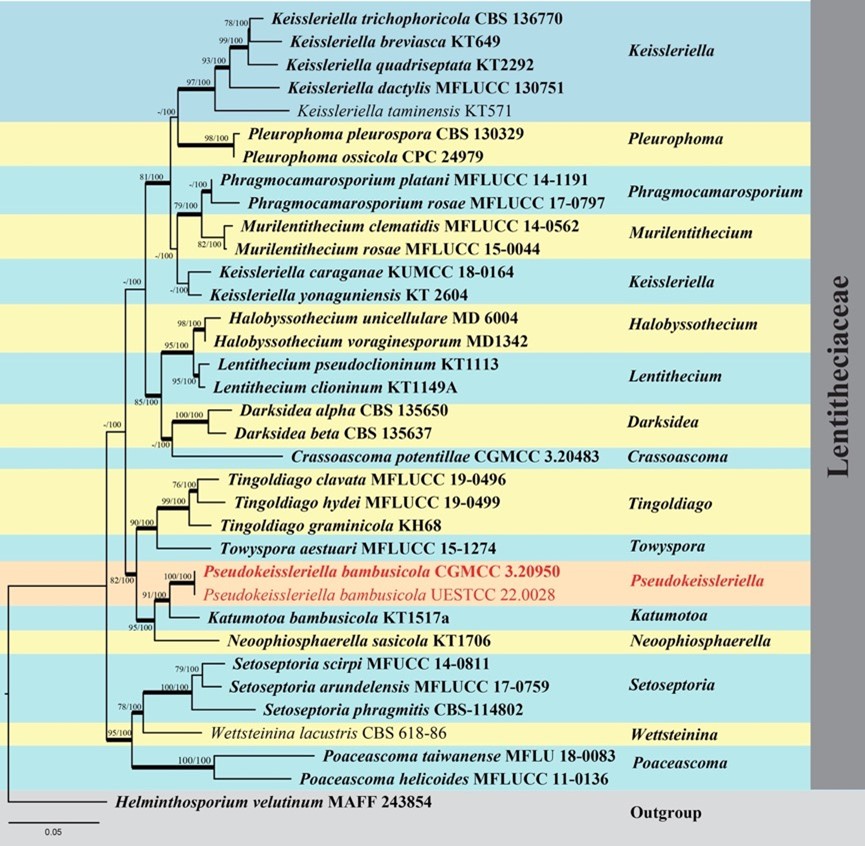Pseudokeissleriella Jian K. Liu, gen. nov.
MycoBank number: MB 844117; Index Fungorum number: IF 844117; Facesoffungi number: FoF 12707;
Etymology: The prefix “pseudo-” means “lying, false”, and the name “Pseudokeissleriella” refers to its morphological similarity to the genus “Keissleriella”.
Saprobic on the living and decayed culms of woody. Sexual morph: Ascomata immersed to slightly erumpent, subglobose, dark brown to black, ostiolate, glabrous, unilocular, coriaceous. Peridium with multi-layers, comprising hyaline to brown cells of textura angularis. Hamathecium trabeculate pseudoparaphyses. Asci 8-spored, bitunicate, cylindrical to cylindric-clavate, short pedicel, with a small ocular chamber. Ascospores overlapping bi-seriate, fusiform, tapering to subobtuse ends, the upper cell is swollen towards the median septum, hyaline, septate, guttulate and surrounded by a mucilaginous sheath. Asexual morph: Undetermined.
Type species: Pseudokeissleriella bambusicola Yi Yang, S.N. Zhang & Jian K. Liu
Notes: The phylogenetic analysis showed that two isolates of Pseudokeissleriella formed a distinct clade in Lentitheciaceae and is closely related to the monotypic genera Katumotoa (type: Ka. bambusicola) and Neoophiosphaerella (type: N. sasicola) (Figure 1). Pseudokeissleriella resembles Katumotoa in having immersed, subglobose ascomata, but they can be distinguished by the ascospores. Pseudokeissleriella has fusiform ascospores tapering to subobtuse ends, with a swollen upper cell near the median septum and mucilaginous sheath, while Katumotoa has apiosporous ascospores with distinctive elongated bipolar mucilaginous sheath (Tanaka & Harada 2005). Pseudokeissleriella differs from Neoophiosphaerella in having immersed, globose ascomata and fusiform, mostly 1-septate ascospores, while the latter has almost superficial, hemispherical, with clypei ascomata and filiform, multi-septate ascospores (Tanaka et al. 2015). In addition, Pseudokeissleriella can be distinguished from Ka. bambusicola and N. sasicola based on sequences data comparison from LSU (14/831; 11/831) and ITS (25/548; 36/548). Pseudokeissleriella is also morphological similar to Keissleriella, but the latter has ascomata with brown setae around the ostiole which is absent in Pseudokeissleriella. Based on a blast search of NCBI GenBank nucleotide database, the LSU sequence of P. bambusicola was closest to Keissleriella dactylis (MFLUCC 130751, NG_059541, identities 98.74%) and Ke. camporesiana (MFLUCC 15-0029, NG_068662, identities 98.39%). The morphology and phylogenetic analyses did not reveal any close associations with other known genera in Lentitheciaceae.

Figure 1. RAxML analysis of Lentitheciaceae based on a concatenated dataset of SSU, ITS, LSU and tef-1α sequence data. Bootstrap support values for maximum likelihood (ML) and maximum parsimony (MP) equal to or greater than 75% were placed above the branches (ML/MP). Bayesian posterior probabilities (BYPP) greater than 0.95 were shown as bold branches. Ex-type strains were in bold and new strains generated in this study were indicated in red.
Species
